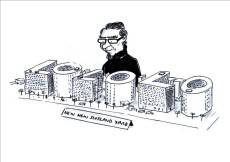October 14, 2013
AHMM chosen for new Met Police headquarters project
The firm of architects chosen for Google’s enormous new North London headquarters project as well as the redevelopment of the BBC’s Television Centre has been chosen to design the new home of the Metropolitan Police in Whitehall. The decision to award the job to Allford Hall Monaghan Morris (AHMM) was announced by the Mayor of London, the Metropolitan Police Commissioner and the Royal Institute of British Architects (RIBA). The Mayor’s Office for Policing And Crime (MOPAC) is selling New Scotland Yard, and moving to modern offices at the iconic Curtis Green building on the Victoria Embankment in 2015. This new building will then revert to being called Scotland Yard.
Architects were initially invited to respond to a RIBA design competition in May 2013, with a shortlist drawn up in July. AHMM’s winning design envisages a police headquarters that claims to be be more open and accessible and will help the Met to reconnect with the public, whilst respecting the heritage of the Whitehall Conservation Area in which it is sited.
Key design features include a new public entrance pavilion, extensions to the building itself and the creation of public open spaces. The world-famous revolving sign will be retained as well as the Eternal Flame and Roll of Honour, currently located at New Scotland Yard in Victoria.
 The redevelopment of the Curtis Green building forms part of the largest ever transformation of the police estate. The move to Curtis Green is part of the MOPAC/MPS Estate Strategy to update its estate. These changes will see a reduction of up to 300,000 sq m – a third of its overall size – helping to reach the MPS target of saving £500m per year by 2015/16
The redevelopment of the Curtis Green building forms part of the largest ever transformation of the police estate. The move to Curtis Green is part of the MOPAC/MPS Estate Strategy to update its estate. These changes will see a reduction of up to 300,000 sq m – a third of its overall size – helping to reach the MPS target of saving £500m per year by 2015/16
According to the Metropolitan Police Service, the cost if they were to remain at New Scotland Yard would be around £30 million per annum, with £50 million additional spend needed for it to meet the specifications for a modern policing operation. By moving to the new site and cutting costs, the Met claim it will be able to invest more in frontline policing, helping to keep officer numbers high, improve the technological capability of the force and develop facilities like a new police training centre in Hendon.
The Met will now work with AHMM to develop the designs further before a planning application is submitted in 2014. Completion of the site is expected in 2015.
Deputy Mayor for Policing and Crime Stephen Greenhalgh said: “Scotland Yard is returning to its historical home in Whitehall. The new, smaller Met HQ will help deliver a 21st century police force and AHMM’s design, which includes a public space, will help Londoners to reconnect with the Met. By selling outdated and impractical buildings like New Scotland Yard that are costly to maintain, we can reduce property running costs. The money raised from the sale of these buildings will be ploughed back into frontline policing so that our officers are equipped with the tools and technology they need to fight crime and to continue to keep London safe.”
Paul Monaghan, Director, Allford Hall Monaghan Morris said: “We are delighted to have won the competition to design the new HQ for the Metropolitan Police within the historic setting of the Curtis Green building. This is a very important project for AHMM with the opportunity to work with one of the most significant and longest established law enforcement bodies in the world. We look forward to working with the Metropolitan Police Service to develop a building that supports them in their changing role within the city.”
Bill Taylor, RIBA Competitions Adviser: “Through the careful extension of the public realm across the site and consideration of its neighbours in massing and materiality terms, these proposals will serve to strengthen this cohesion. ‘Weaving’ the heritage and culture of the Metropolitan Police into the fabric of the building and the spaces that surround it, the proposals strike a balance between respect for what already exists and the desire of the client to present a new, open and progressive face to the community they serve.”














